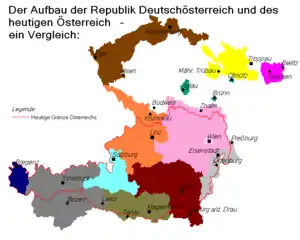Province of German Bohemia
The Province of German Bohemia (German: ![]() Provinz Deutschböhmen ; Czech: Německé Čechy) was a province in Bohemia, now the Czech Republic, established for a short period of time after the First World War, as part of the Republic of German-Austria.
Provinz Deutschböhmen ; Czech: Německé Čechy) was a province in Bohemia, now the Czech Republic, established for a short period of time after the First World War, as part of the Republic of German-Austria.
It included parts of northern and western Bohemia, at that time primarily populated by ethnic Germans. Important population centers were Reichenberg (now Liberec), Aussig (Ústí nad Labem), Teplitz-Schönau (Teplice), Dux (Duchcov), Eger (Cheb), Marienbad (Mariánské Lázně), Karlsbad (Karlovy Vary), Gablonz an der Neiße (Jablonec nad Nisou), Leitmeritz (Litoměřice), Brüx (Most) and Saaz (Žatec). The land that comprised the province would later form an integral part of the territory later known as the "Sudetenland".
History

Archaeologists have found evidence of Celtic and Boii migrations through the Bohemia in the 3rd century BC. The Germanic settlement started in the 1st century AD. Slavic people from the Black Sea-Carpathian region settled here in the 7th century. Germans came as merchants in the 10th century. In the High Middle Ages, they started settling in the less populated border regions. Lands constituting German Bohemia were historically an integral part of the Duchy and Kingdom of Bohemia. Later, with the imminent collapse of Habsburg Austria-Hungary at the end of First World War, areas of Bohemia with an ethnic German majority began to take action to avoid joining a new Czechoslovak state. On 27 October 1918, the Egerland declared independence from Bohemia and a day later the independence of Czechoslovak Republic was proclaimed in the Bohemian capital of Prague.[1]
On 11 November 1918, Emperor Charles I of Austria relinquished power and, on 12 November, the ethnic German areas of the empire were declared the Republic of German Austria, with the intent of unifying with the German Reich. The Province of German Bohemia was formed from the part of Bohemia that contained primarily ethnic Germans (however, ethnic German areas of southwestern Bohemia in the Bohemian Forest were added to Upper Austria instead of German Bohemia).[1] The capital of the province was at Reichenberg.
In 1919, the territory of the province was inhabited by 2.23 million ethnic Germans, and 116,275 ethnic Czechs.[2]
A sister province, the Province of the Sudetenland, was formed alongside German Bohemia, made up of German-speaking parts of Moravia and Silesia. This province had radically different boundaries than later conceptions of the term "Sudetenland".
In late November 1918, the Czechoslovak army began an invasion of Province of German Bohemia and during December it occupied the whole region, with Reichenberg falling on 16 December and the last major city, Leitmeritz, falling on 27 December 1918. The Province of the Sudetenland faced the same fate.
The status of the German areas in Bohemia, Moravia, and Austrian Silesia was definitively settled by the 1919 peace treaties of Versailles and Saint-Germain-en-Laye, which declared that the areas belong to solely to Czechoslovakia. The Czechoslovak government then granted amnesty for all activities against the new state.
The region that had been German Bohemia was reintegrated into the Province of Bohemia (Země česká) of the Czechoslovak Republic. This remained the case until the Munich Agreement, when Czechoslovakia was forced to give up the German-inhabited areas of its domain, at the behest of Nazi Germany. The Nazis would incorporate the former German Bohemia into the Reichsgau of the Sudetenland, a new administrative unit that contained all the German-speaking parts of the former Bohemian Crown.[1] Around 165,000 Czechs who lived in these areas quickly fled (or were forced to flee) in fear of reprisals by the Sudetendeutsches Freikorps, a Nazi-sponsored militia. A half year later, however, Germany invaded the remaining parts of the Czech lands (Rest-Tschechei in German), and carved out new puppet states from the formerly independent country.
After the war, all of this land was reincorporated into a new Czechoslovak Republic. The vast majority of the German population (more than 94%) were expelled from Czechoslovak territory: many were killed or died during their flight from both Czech and Soviet attackers.[1]
Notes
- Prinz, Friedrich (1993). Deutsche Geschichte in Osten Europas: Böhmen und Mähren (in German). Berlin: Wolf Jobst Siedler Verlag GmbH. p. 381. ISBN 3-88680-200-0. Retrieved 25 February 2013.
- Klaus Berchtold (in German): 1918–1933. Fünfzehn Jahre Verfassungskampf (Verfassungsgeschichte der Republik Österreich, Bd. 1), Springer, Vienna 1998, ISBN 3-211-83188-6, S. 103.
References
- de Zayas, Alfred M.: A terrible Revenge. Palgrave/Macmillan, New York, 1994. ISBN 1-4039-7308-3.
- de Zayas, Alfred M.: Nemesis at Potsdam. London, 1977. ISBN 0-8032-4910-1.
- Douglas, R.M.: Orderly and Humane. The Expulsion of the Germans after the Second World War. Yale University Press 2012. ISBN 978-0-30016-660-6.
- Franzel, Emil: Sudetendeutsche Geschichte. Mannheim, 1978. ISBN 3-8083-1141-X.
- Meixner, Rudolf: Geschichte der Sudetendeutschen. Nürnberg, 1988. ISBN 3-921332-97-4.